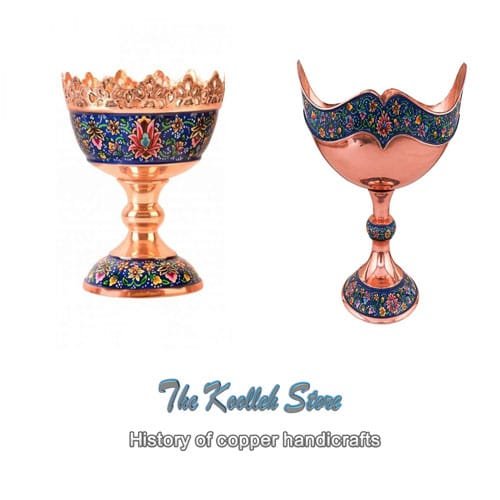History of copper handicrafts

Copper handicrafts About 5,000 years ago, the cave dwellers of the Iranian plateau turned to the plains due to changes in climate and the formation of farms and meadows, and began a new life in their civilization compared to earlier times. More progress was made. The people who lived on the plateau of Iran occasionally made pottery and made objects with flowers, and by cooking them, they created beautiful works from them. They sometimes observed that some of their pottery did not break as a result of the impact, and that they sometimes took out of the containers that were set on fire, which became hard after cooling.
They named the material copper and used it extensively in the manufacture of agricultural utensils and tools. At the end of the later Stone Age, the people of this region made their tools and instruments with copper, and at least such tools replaced the stone tools that were common until then. In the fourth millennium BC, the people of the plateau of the Iranian plateau made more progress in the work of life, although stone was used in the manufacture of tools and implements in this era. They did not know how to make metals, and they made pins and delicate utensils with copper.
During this period, copper smelting also became common, and tools and implements were made by casting. In the settlements of the mentioned period, knives and stickers with copper blades have been obtained. Also, in the excavations of Silk Kashan, some copper mirror has been obtained for makeup. One of the features of this period is the presence of gold and azure earrings.
Copper was known for a number of ancient civilizations, and its use dates back to at least 10,000 years ago. A copper pendant dating to 8700 BC has been found in what is now northern Iraq. There are indications that copper will melt and purify its oxides, such as malachite and azurite, by 5,000 BC. Instead, the first signs of gold dating back to about 4,000 BC.
Copper and bronze artifacts from Sumerian cities and Egyptian artifacts from copper and tin alloys date back to about 3,000 BC. One of the pyramids contains a copper piping system dating back 5,000 years. The Egyptians found that adding a small amount of tin made it easier to form copper, so the bronze alloys discovered in Egypt are almost as old as copper. The use of copper in ancient China dates back to at least 2000 BC, and up to 1,200 BC, high-quality bronze was made in this country.
Keep in mind that because copper melts easily for reuse and re-use, the period is affected by wars and landslides. In Europe, the icy man, a carefully preserved man from 3,300 BC found in northern Italy near the Austrian border, holds a copper-tipped ax with a metal purity of 99.7%. The large amount of arsenic in her hair indicates her work with copper refining. The best examples of copper in Iran are the copper handicrafts of Isfahan.
The use of bronze in a phase of civilization was so pervasive that it was called the Bronze Age. Rice was known to the Greeks, but was first widely used by the Romans. Because of its brilliant beauty – as it was used in ancient times to make mirrors – and because of its connection to the goddess Cyprus, it is associated with the goddesses Aphrodite and Venus in the mythology and alchemy of copper metal. In alchemy, the sign they intended for copper was also the sign of Venus.






